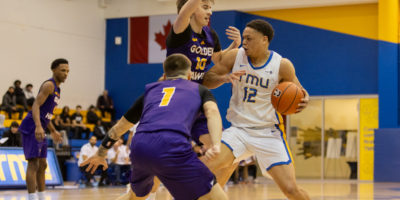By Diana H. Dicklich
While necessity has forced Ryerson’s applied arts faculties to restructure their curricula, most chairs say that downsizing actually improves their programs.
The Deans are currently reviewing the four-year program plans submitted to them by chairs and directors in the latest stage of a multi-year planning and restructuring process dubbed Financial Management Plan Two (FMP2). Their recommendations will be forwarded to VP-Academic Dennis Mock.
Ryerson’s low student-instructor ratio means that students spend more time in the classroom with their instructors than any other university in Canada. John Kitamura, the Dean of Applied Arts, says that this luxury costs too much and must change. “Ryerson can no longer afford the same curriculum in the same way,” he said. “There is no choice, it is not debatable.”
As a result, courses and course hours are being cut from the timetable, with classes being combined and teaching assistants used when possible.
Galie McGregor, chairs of Film and Photography, believes the restructuring program is a blessing in disguise.
“Instead of approaching it from a negative viewpoint, we have started from the ground up and rebuilt a brand new curriculum which I think is very strong.”
Despite the optimism, the Film and Photography department has suffered major problems. McGregor said that equipment resources are badly eroded, and some camera equipment is held together with bailing wire, or doesn’t work at all.
While departments may be approaching these challenges in creative ways, the facts remain. By the time the eight-year financial management planning process is completed in 1988/99 there will have been a permanent reduction of $15.8 million in provincial funding as recognition of its new university status. The funding will be phased in over a six-year period from 1993 to 1999.
These funds will establish graduate programs, scholarly, research and creative (SRC) activities and new activities to develop undergraduate programs.
The new curricula will reduce teaching costs, even though some departments have little money to replace or acquire new equipment.
“I’m lucky that no large piece of equipment has gone to the point where we have to replace it,” said Lorna Kelly, chair of the School of Interior Design. “If we had to replace one of those machines that costs thousands and thousands of dollars we just couldn’t do it.”
According to Frank McGuire, chair of the School of Graphic Communications Management, his program would have been “up against the wall” if it didn’t have the support of the graphic communications industry. He estimates that in the last four years, the industry contributed about $2 million in financial support and equipment to his department. “Four or five years ago, this place was a museum. Now it’s the best equipped school in the university,” he said.
McGuire is convinced that partnerships with industry are the key to the future, and he has gone out himself to seek and develop these partnerships. The Dean of Applied Arts and most chairs agree with him. In departments where the teaching staff is over-extended, however, the ability to secure funding from the private sector is next to impossible.










Leave a Reply